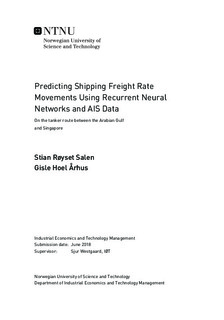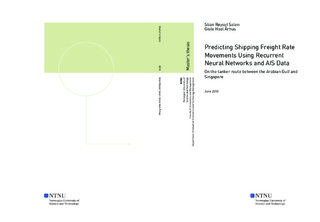| dc.description.abstract | The purpose of this thesis is twofold. Firstly, we want to predict shipping freight rates in the liquid crude oil tanker market, applying a machine learning technique suitable for processing time-series (sequential) data, such as Long Short-Term Memory (LSTM) Neural Networks (NN). Secondly, an important objective of this thesis is to investigate the predictive ability of satellite Automatic Identification System (AIS) data. AIS potentially provides real-time data on for example the current position, past routing and headed destination of ships world-wide. We examine whether this type of data adds valuable information, on top of other fundamental and financial data, with respect to the prediction of freight rate movements in the tanker shipping market. A total of 17 explanatory variables are included in the study, selected based on a thorough literature review of tanker freight rate determinants; eleven of the variables are derived from AIS data, and the other six are fundamental and financial variables gathered from Thomson Reuters Eikon. The applied data set contains time series of these 17 variables in the sample period 4 January 2012 to 24 December 2015.
Specifically, a type of recurrent neural networks, an LSTM NN model developed based on TensorFlow, is utilised to predict future price fluctuations on the major tanker route between the Arabian Gulf (AG) and Singapore, over the following short-term horizons: one day-, five days- and ten days ahead. This route is defined as TD2 by the Baltic Exchange. Furthermore, this model is applied to determine whether it achieves better prediction (or classification) accuracy by adding AIS data as input variables. A three-dimensional solution space is examined: Numerous experiments are performed, investigating the use of various subsets of explanatory variables (combinations of the 17 selected variables), over three different forecasting horizons, using two degrees of model complexity. Moreover, a multivariate linear regression model is utilised to provide benchmark results.
The findings of this thesis indicate that the LSTM NN model provides promising results when forecasting ten days ahead; the LSTM NN model outperforms the benchmark model in all six experiments carried out. However, on the shorter forecasting horizons (one day- and five days ahead), the benchmark model competes well with the LSTM NN model. The results further indicate that the LSTM NN model does not achieve significantly better prediction (or classification) accuracy by adding AIS data as model input. However, the quality of the applied AIS data is questionable. Thus, by sampling new and more recent AIS data, the forecasting results could be improved. Moreover, certain measures and techniques can be applied to attempt to enhance the LSTM NN model performance. | |

